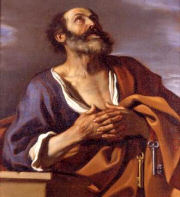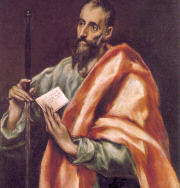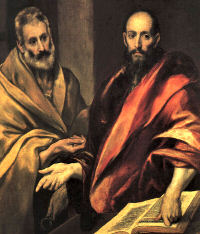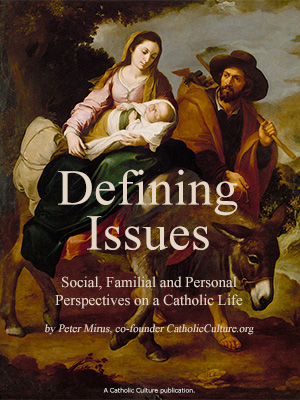Make your gift today!
Help keep Catholics around the world educated and informed.
Already donated? Log in to stop seeing these donation pop-ups.
Ordinary Time: June 29th
Solemnity of Sts. Peter and Paul, apostles
» Enjoy our Liturgical Seasons series of e-books!
Veneration of the two great Apostles, Peter and Paul, has its roots in the very foundations of the Church. They are the solid rock on which the Church is built. They are at the origin of her faith and will forever remain her protectors and her guides. To them Rome owes her true greatness, for it was under God's providential guidance that they were led to make the capital of the Empire, sanctified by their martyrdom, the center of the Christian world whence should radiate the preaching of the Gospel.
St. Peter suffered martyrdom under Nero, in A.D. 66 or 67. He was buried on the hill of the Vatican where recent excavations have revealed his tomb on the very site of the basilica of St. Peter's. St. Paul was beheaded in the via Ostia on the spot where now stands the basilica bearing his name. Down the centuries Christian people in their thousands have gone on pilgrimage to the tombs of these Apostles. In the second and third centuries the Roman Church already stood pre-eminent by reason of her apostolicity, the infallible truth of her teaching and her two great figures, Sts. Peter and Paul.
A plenary indulgence may be gained today by anyone who makes devout use of a religious article blessed by a bishop and who also recites any approved profession of faith (e.g. the Apostles Creed), as long as the usual conditions are satisfied.
Catholic Culture prepared this special section during the Year of St. Paul.
St. Peter
 Peter's original name was Simon. Christ Himself gave him the name Cephas or Peter when they first met and later confirmed it. This name change was meant to show both Peter's rank as leader of the apostles and the outstanding trait of his character — Peter (in Hebrew Kephas) the Rock. Peter was born in Bethsaida on the Sea of Galilee. Like his younger brother Andrew, he was a fisherman and dwelt at Capernaum. Peter's house often became the scene of miracles, since the Master would stay there whenever He was teaching in that locality. Together with his brothers John and Andrew, Peter belonged to the first of Jesus' disciples (John 1:40-50).
Peter's original name was Simon. Christ Himself gave him the name Cephas or Peter when they first met and later confirmed it. This name change was meant to show both Peter's rank as leader of the apostles and the outstanding trait of his character — Peter (in Hebrew Kephas) the Rock. Peter was born in Bethsaida on the Sea of Galilee. Like his younger brother Andrew, he was a fisherman and dwelt at Capernaum. Peter's house often became the scene of miracles, since the Master would stay there whenever He was teaching in that locality. Together with his brothers John and Andrew, Peter belonged to the first of Jesus' disciples (John 1:40-50).
After the miraculous draught of fish on the Sea of Galilee, Peter received his definitive call and left wife, family, and occupation to take his place as leader of the Twelve. Thereafter we find him continually at Jesus' side, whether it be as spokesman of the apostolic college (John 6:68; Matt. 16:16), or as one specially favored (e.g., at the restoration to life of Jairus' daughter, at the transfiguration, during the agony in the garden). His sanguine temperament often led him into hasty, unpremeditated words and actions; his denial of Jesus during the passion was a salutary lesson. It accentuated a weakness in his character and made him humble.
After the ascension, Peter always took the leading role, exercising the office of chief shepherd that Christ had entrusted to him. He delivered the first sermon on Pentecost and received the first Gentiles into the Church (Cornelius; Acts 10:1). Paul went to Jerusalem "to see Peter." After his miraculous deliverance from prison (Easter, 42 A.D.), Peter "went to a different place," most probably to Rome. Details now become scanty; we hear of his presence at the Council of Jerusalem (Acts 15:1), and of his journey to Antioch (Gal. 2:11).
It is certain that Peter labored in Rome as an apostle, that he was the city's first bishop, and that he died there as a martyr, bound to a cross (67 A.D.). According to tradition he also was the first bishop of Antioch. He is the author of two letters, the first Christian encyclicals. His burial place is Christendom's most famous shrine, an edifice around whose dome are inscribed the words: Tu es Petrus, et super hanc petram aedificabo ecclesiam meam.
—Excerpted from The Church's Year of Grace, Pius Parsch
Patronage: Against frenzy; bakers; bridge builders; butchers; clock makers; cobblers; Exeter College Oxford; feet problems; fever; fishermen; harvesters; locksmiths; longevity; masons; net makers; papacy; Popes; ship builders; shipwrights; shoemakers; stone masons; Universal Church; watch makers; Poznan, Poland; Rome; Diocese of Jackson, Mississippi; Diocese of Las Vegas, Nevada; Diocese of Marquette, Michigan; Archdiocese of Philadelphia, Pennsylvania; Diocese of Providence, Rhode Island; Diocese of Scranton, Pennsylvania. See the full list at CatholicSaints.info.
Symbols and Representation: Two keys saltire; pastoral staff and two large keys; inverted cross; inverted cross and two keys saltire; crowing cock; fish; two swords; patriarchal cross and two keys saltire; two keys and a scroll; sword
Often portrayed as: Bald man, often with a fringe of hair on the sides and a tuft on top; book; keys; man crucified head downwards; man holding a key or keys; man robed as a pope and bearing keys and a double-barred cross
Highlights and Things to Do:
- Read more about St. Peter:
- Besides the recipes in the Catholic Culture Liturgical Year section, the cookbook Cooking With the Saints by Ernst Schuegraf has seven recipes alone for the feast of St. Peter. This is a wonderful book, beautifully illustrated with art of the saints and the actual dishes. This would be a great addition to your liturgical year library. See also Catholic Cuisine for further feast food ideas.
- Watch this YouTube video about St. Peter.
- Father Francis X. Weiser describes customs and traditions of this feast day. See the blue sidebar for more Prayers, Activities and Customs.
- See the list of all the churches in Rome related to St. Peter, and visit the websites:
- First Class Relic: St. Peter's Basilica
- First Class Relic: Archbasilica of St. John Lateran
- Domini Quo Vadis (Lord, where are you going?)
- San Pietro in Vincoli (St. Peter in Chains)
- San Pietro in Montorio (Saint Peter in Montorio)
- San Giuseppe dei Falegnami / Carcere Mamertino (Saint Joseph of the Carpenters / Mamertine Prison) The original church was erected above the Mamertine Prison, where St. Peter and St. Paul were held prisoner.
- Santa Maria del Popolo, famous for the image by Caravaggio, Crucifixion of St. Peter
- Basilica of San pudenziana, "It is believed that St Peter lodged here while he was in Rome."
- Santa Francesca Romana (Saint Frances of Rome), "Two flagstones within the right transept of the church are said to bear the imprints of the knees of St Peter."
- San Sebastiano Fuori Le Mura (Saint Sebastian Outside the Walls), "This church has an ancient tradition connecting it to St Peter and St Paul. The Depositio Martyrum shows that in the year 258 pilgrims came to San Sebastiano Fuori Le Mura on June 29th, the Feast Day of Saints Peter and Paul, to honor these two great saints. Therefore, it is presumed that at one time this church housed the remains of both St Peter and St Paul."
- This site has a wealth of info and images of St. Peter's Basilica.
- "Quo Vadis" is one of the traditional stories of St. Peter for his call to return to Rome for his martyrdom. the Diocese of Arlington uses this title for their vocations discernment.
- 15 Places in the Holy Land to Visit.
- The Church of the Primacy of St. Peter in Israel is a humble chapel, rebuilt in 1933. It contains the Mensa Christi, Latin for "Table of Christ" where Jesus served breakfast.
- A collection of some paintings of St. Peter, the Apostle.
St. Paul
 Paul, known as Saul (his Roman name) before his conversion, was born at Tarsus in the Roman province of Silicia about two or three years after the advent of the Redeemer. He was the son of Jewish parents who belonged to the tribe of Benjamin, was reared according to the strict religious-nationalistic party of the Pharisees, and enjoyed the high distinction of Roman citizenship.
Paul, known as Saul (his Roman name) before his conversion, was born at Tarsus in the Roman province of Silicia about two or three years after the advent of the Redeemer. He was the son of Jewish parents who belonged to the tribe of Benjamin, was reared according to the strict religious-nationalistic party of the Pharisees, and enjoyed the high distinction of Roman citizenship.
As a youth he went to Jerusalem to become immersed in the Law and had as a teacher the celebrated Gamaliel. He acquired skill as a tent-maker, a work he continued even as an apostle. At the time of Jesus' ministry he no longer was at Jerusalem; neither did he see the Lord during His earthly-life. Upon returning to the Holy City, Paul discovered a flourishing Christian community and at once became its bitter opponent. When Stephen impugned Law and temple, Paul was one of the first at his stoning; thereafter his fiery personality would lead the persecution. Breathing threats of slaughter against the disciples of Jesus, he was hurrying to Damascus when the grace of God effected his conversion (about the year 34 A.D.; see January 25, Conversion of St. Paul).
After receiving baptism and making some initial attempts at preaching, Paul withdrew into the Arabian desert (c. 34-37 A.D.), where he prepared himself for his future mission. During this retreat he was favored with special revelations, Christ appearing to him personally. Upon his return to Damascus he began to preach but was forced to leave when the Jews sought to kill him. Then he went to Jerusalem "to see Peter." Barnabas introduced him to the Christian community, but the hatred of the Jews again obliged him to take secret flight. The following years (38-42 A.D.) he spent at Tarsus until Barnabas brought him to the newly founded Christian community at Antioch, where both worked a year for the cause of Christ; in the year 44 he made another journey to Jerusalem with the money collected for that famine stricken community.
The first major missionary journey (45-48) began upon his return as he and Barnabas brought the Gospel to Cyprus and Asia Minor (Acts 13-14). The Council of Jerusalem occasioned Paul's reappearance in Jerusalem (50). Spurred on by the decisions of the Council, he began the second missionary journey (51-53), traveling through Asia Minor and then crossing over to Europe and founding churches at Philippi, Thessalonia (his favorite), Berea, Athens, Corinth. He remained almost two years at Corinth, establishing a very flourishing and important community. In 54 he returned to Jerusalem for the fourth time.
Paul's third missionary journey (54-58) took him to Ephesus, where he labored three years with good success; after visiting his European communities, he returned to Jerusalem for a fifth time (Pentecost, 58). There he was seized by the Jews and accused of condemning the Law. After being held as a prisoner for two years at Caesarea, he appealed to Caesar and was sent by sea to Rome (60 A.D.). Shipwrecked and delayed on the island of Malta, he arrived at Rome in the spring of 61 and passed the next two years in easy confinement before being released. The last years of the saint's life were devoted to missionary excursions, probably including Spain, and to revisiting his first foundations. In 66 he returned to Rome, was taken prisoner, and beheaded a year later. His fourteen letters are a precious legacy; they afford a deep insight into a great soul.
—Excerpted from The Church's Year of Grace, Pius Parsch
Patronage: Against snakes; authors; Cursillo movement; evangelists; hailstorms; hospital public relations; journalists; lay people; missionary bishops; musicians; poisonous snakes; public relations personnel; public relations work; publishers; reporters; rope braiders; rope makers; saddlemakers; saddlers; snake bites; tent makers; writers; Malta; Rome; Poznan, Poland; newspaper editorial staff, Archdiocese of Philadelphia, Pennsylvania; Diocese of Covington, Kentucky; Diocese of Birmingham, Alabama; Diocese of Las Vegas, Nevada; Diocese of Providence, Rhode Island; Diocese of Worcester, Massachusetts. See the full list at CatholicSaints.info.
Symbols and Representation: Book and sword, three fountains; two swords; scourge; serpent and a fire; armour of God; twelve scrolls with names of his Epistles; Phoenix; palm tree; shield of faith; sword; book
Often portrayed as: Thin-faced elderly man with a high forehead, receding hairline and long pointed beard; man holding a sword and a book; man with 3 springs of water nearby
Highlights and Things to Do:
- From the Directory on Popular Piety, this feast is important because "it is always useful to teach the faithful to realize the importance and significance of the feasts of those Saints who have had a particular mission in the history of Salvation, or a singular relationship with Christ such as St. John the Baptist (24 June), St. Joseph (19 March), Sts. Peter and Paul (29 June), the Apostles and Evangelists, St. Mary Magdalen (22 July), St. Martha (29 July) and St. Stephen (26 December)."
- The Directory on Popular Piety also explains the devotion of the Christian Pilgrimage. During the Middle Ages in particular, "pilgrims came to Rome to venerate the tombs of the Apostles Peter and Paul (ad Limina Apostolorum), the catacombs and basilicas, in recognition of the service rendered to the universal Church by the successor of Peter."
- Read more about St. Paul:
- Father Francis X. Weiser describes customs and traditions of this feast day. See the blue sidebar for more Prayers, Activities and Customs.
- Learn more about St. Paul, read Paul of Tarsus, by Joseph Holzner.
- Visit Catholic Cuisine for further food ideas.
- See this list of churches that bear relics or have close connection to St. Paul, then visit the sites:
- First Class Relic: Basilica of St. Paul Outside the Walls contains St. Paul's remains and chains, and painting of the Conversion of St. Paul by Vincenzo Camuccini
- First Class Relic: Archbasilica of St. John Lateran
- First Class Relic: Church of St. Paul's Shipwreck in Malta
- San Paolo alle Tre Fontane, or Church of the Three Fountains, marking the three spots where his head bounced and Santa Maria Scala Coeli (Saint Mary of the Stairway to Heaven), the place where St. Paul was imprisoned, all part of Tre Fontane Abbey, where the lambs are raised whose wool is used for the pallia, given to the new archbishops on this feast day.
- San Sebastiano Fuori Le Mura (Saint Sebastian Outside the Walls), "This church has an ancient tradition connecting it to St Peter and St Paul. The Depositio Martyrum shows that in the year 258 pilgrims came to San Sebastiano Fuori Le Mura on June 29th, the Feast Day of Saints Peter and Paul, to honor these two great saints. Therefore, it is presumed that at one time this church housed the remains of both St Peter and St Paul."
- San Paolo alla Regola ((Saint Paul at the Regola), built over the house St. Paul lived under house arrest for 2 years.
- Santa Maria in Via Lata (Our Lady on Via Lata) (also here), also built over a place where St. Paul lived under house arrest.
- Santa Maria del Popolo, famous for the image by Caravaggio, Conversion of St. Paul.
- San Pietro in Montorio (Saint Peter in Montorio) contains "A painting within the right transept by Giorgio Vasari depicts the Conversion of St Paul."
- Santa Maria in Campitelli (Our Lady in Campitelli) contains another painting of the Conversion of St. Paul by Ludovico Geminiani.
- Follow along St. Paul's journeys.
- See the work of the St. Paul Center for Biblical Theology, founded by Dr. Scott Hahn. This is a work that is following the footsteps of St. Paul in our modern world. Highlight: listen to the podcast by Dr. Scott Hahn on St. Paul.
- What did it mean to be a tent maker in St. Paul's time? Find out more. Perhaps in honor of St. Paul (and St. Peter, thinking of the Transfiguration), tents could be erected today, whether for camping, shade outdoors, or just a fun play tent inside.






